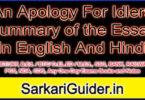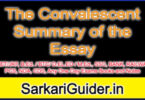Keats as a writer of odes

Keats as a writer of odes
Write a short note on Keats as a writer of odes.
1. Introduction :
Keats as a writer of odes– Keats has left behind a number of beautiful odes. The most prominent of them are – “The ode to a Nightingale”, “Ode to Autumn”, “Ode on Melancholy”, “Ode on a Grecian urn”, Ode on Indolence”, and “Ode to Psyche”. These odes represent the best of Keats’s poetry. Critics have greatly admired these Odes which are charged with a peculiar intensity. The Odes of Keats constitute a class apart in English literature in form and manner. A.C. Swinburne rightly remarks.
“Greater lyrical poetry the world may have seen than any that is in these Odes, lovelier it surely has never seen nor even can it possibly see”.
Keats’s odes are no doubt the best specimens of his poetry. His genius found its perfect expression in the odes. His odes really represent his artistic perfection at the best.
2. Salient features of Keats’s Odes :
Though this is not certainly the rule, the ode is usually an address. The poet in his personal voice addresses some abstraction or Quality of person. An ode is loaded with lyric enthusiasm. It is written on an exalted theme and in a metrical form which is always complex and elaborate.
All the prominent odes of Keats have all these qualities in abundance. Most of Keat’s odes are serious and contemplative lyrics in which the poet addresses something or some person. The theme of these odes is exalted, dignified and serious. The style is elevated. The metrical structure is highly complex, and the entire poem reflects a logical development. The odes also show the great imaginative power of Keats. The splendid phrascology reveals the great artistic achievement of the poet. Keats’s odes do not suffer from the defects of artificiality or rhetorical effusions. In these odes, Keats has found a form of lyrics utterance which gives utmost expression to his genius. selincourt has remarked.
“He stands without a rival, as the poet of the richly meditative ode”.
3. A Perfection of artistic Beauty :
The odes very artistically express Keats’s sensuous enjoyment of beauty. Through these odes, the poet describes the beauty of nature, changing human moods, Grecian art, Melodious song of the nightingale, the mellow fruitfulness of Autumn and the romance of psyche. Thus the poet proclaims that
“Beauty is truth, Truth beauty, That is all,
Ye know on earth and all ye need to know”.
4. A deep sense of Melancholy:
Along with his sensuous enjoyment, the odes also present the deepest melancholy. The poet expresses his personal anguish and grief through these odes. The sad death of his brother Tom, The Poet’s own illness and poor health, adverse criticism of his literary achievement, and above all anguish of unfulfilled love for Fanny Brawne all find an echo in these beautiful odes. In ‘Ode to a Nightingale’, Keats says-
“The weariness, the fever and the fret
Here, Where men sit and here each other groan
Where palsy shakes a few, sad last grey hairs,
Where youth grows pale, and spectre-thin and dies.”
These lines also reflect deep human emotion and a universal feeling profound melancholy at the sufferings and afflictions of mankind. The Key-note of his odes is thus the spirit of sadness which predominated during the closing years of the poet’s life.
5. All Illustration of Negative Capability –
However, the poet faced the slings of fortune calmly, and consequently the odes reflect a mode of complete self-effacement. The ‘Ode to Autumn’ can be stated as a perfect example of that calm and poise which is born of the Negative Capability.
6. Immortality of art –
Keats also contemplates on the translent nature of human joy while art is permanent. This is well illustrated in his famous “Ode on Grecian urn” where the bold lover engraved on the Grecian urn can not kiss his beloved but is advised by the poet not to grieve because ‘She can not fade, though thou hast not thy bliss”. Even in ‘Ode to Nightingale’, the poet confirms the permanent value of art when he states no hungry generations can treated the art of the Nightingale.
“Thou wast not born for death, immortal Bird!
No hungry generations tread the down”.
7. Lyric flow and predominating seriousness
Thus the ode contains the most intimate feelings and emotions of the poet. It is composed in a lyric form in which the poet speaks in his personal voice. It is built upon a serious and dignified theme and is subjective in nature. It comprises a succession of elaborate stanzas in stately and dignified style. Alogwith lyrical flow, we also observe ideas of deep solemnity and impressiveness. Thus the personal ideas are transformed into universal and philosophical ideas, Keat’s odes are all personal and subjective not inspired by occasions of public importance. However, he is objective and not interested in his own feelings while composing the ‘Ode to Autumn’. In this ode the poet describes the season in humanised way and mostly remains detached to his own sorrow. However, in all the odes of Keats the element of basic seriousness predominates. Keat’s odes are all of the regular variety and form a class by themselves. Keats deals with the problems of life in general and asserts the fact that art is permanent and eternal.
8. Conclusion :
Keats’s odes are no doubt supreme in their class. They are unsurpassed in their dignity and melodic beauty. Each ode is remarkable for its pictorial art, rich imagery, sensuousness and suggestion. Each ode originates from a definite mood of the poet and by its regular movement and rhythmic expression gives us a lot of delight. Keats’s odes are great examples of high excellence and poetic art. In their technique and structure, the odes are peerless. in symbolic depth. The language of the odes is colourful and vibrant.
La Belle Dame sans Merci Poem Summary
Important Links
- John Keats Biography
- Percy Bysshe Shelley Biography
- William Wordsworth as a Romantic Poet
- William Wordsworth as a poet of Nature
- William Wordsworth Biography
- William Collins Biography
- John Dryden Biography
- Alexander Pope Biography
- Metaphysical Poetry: Definition, Characteristics and John Donne as a Metaphysical Poet
- John Donne as a Metaphysical Poet
- Shakespeare’s Sonnet 116: (explained in hindi)
- What is poetry? What are its main characteristics?
- Debate- Meaning, Advantage & Limitations of Debate
- Sarojini Naidu (1879-1949) Biography, Quotes, & Poem Indian Weavers
- Charles Mackay: Poems Sympathy, summary & Quotes – Biography
- William Shakespeare – Quotes, Plays & Wife – Biography
- Ralph Waldo Emerson – Poems, Quotes & Books- Biography
- What is a lyric and what are its main forms?






